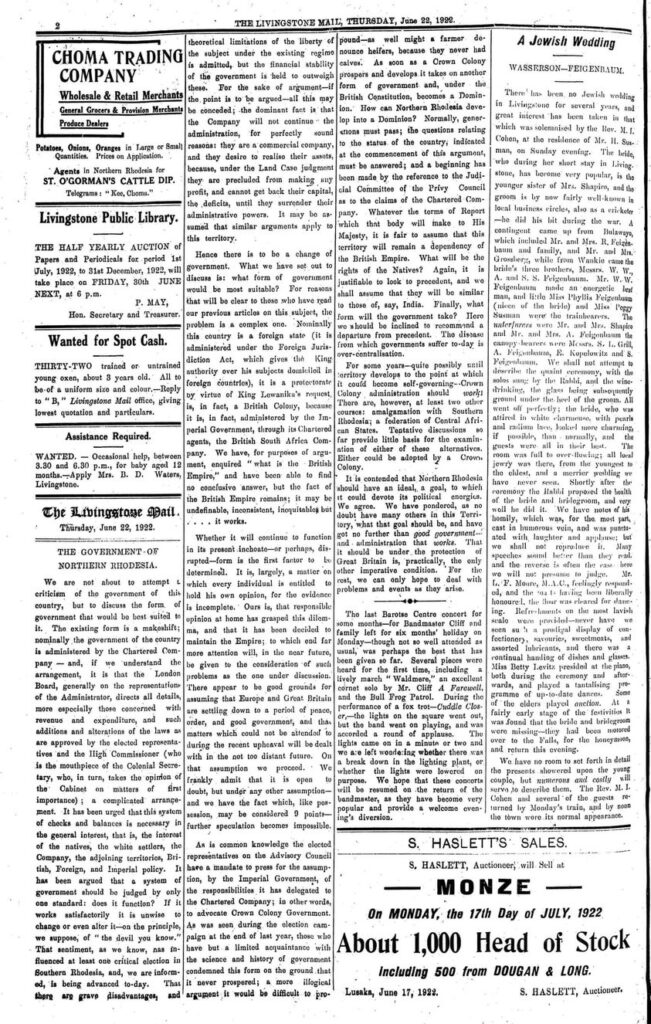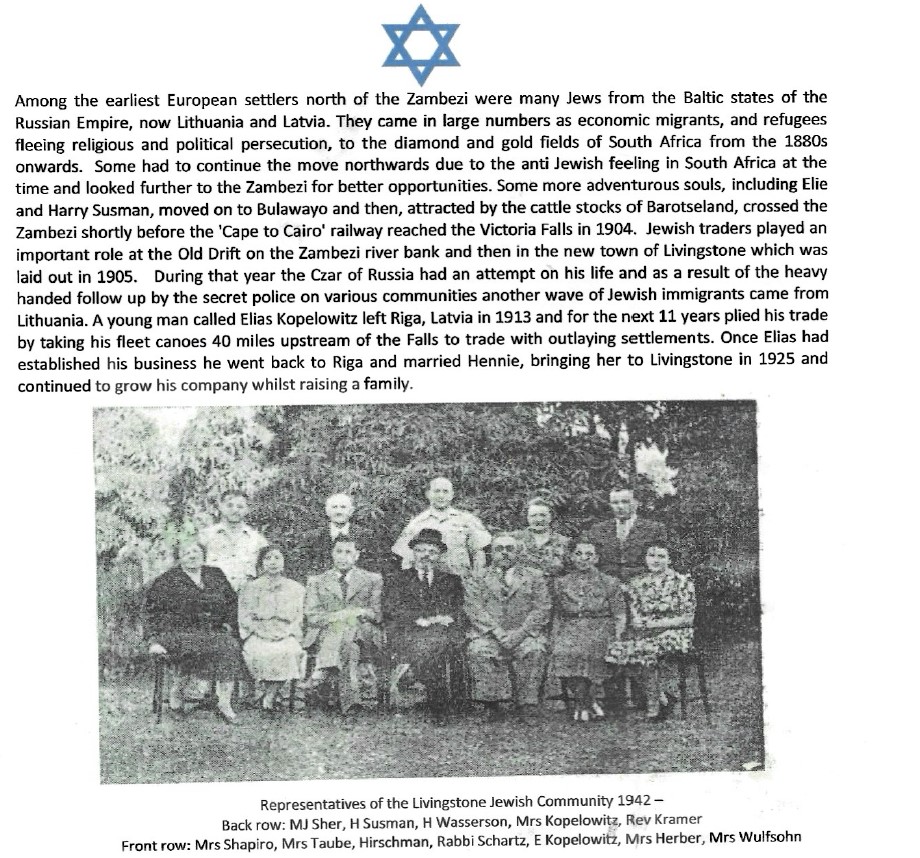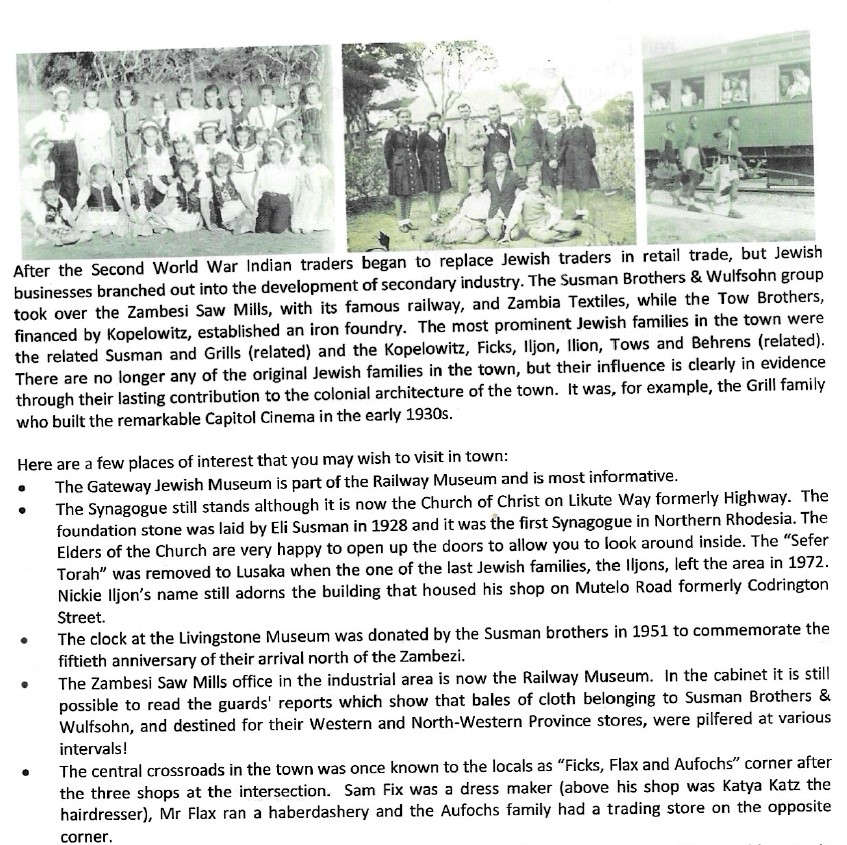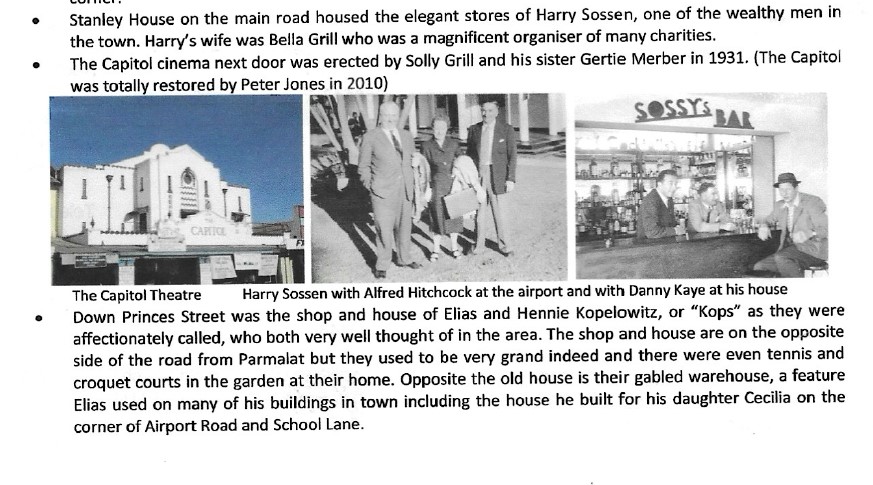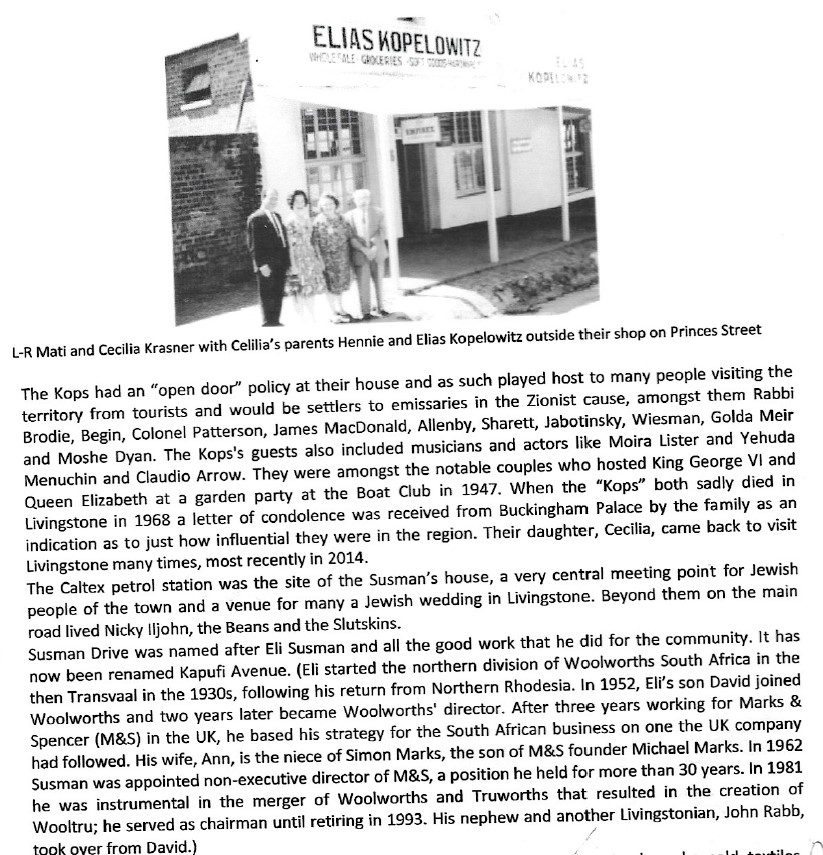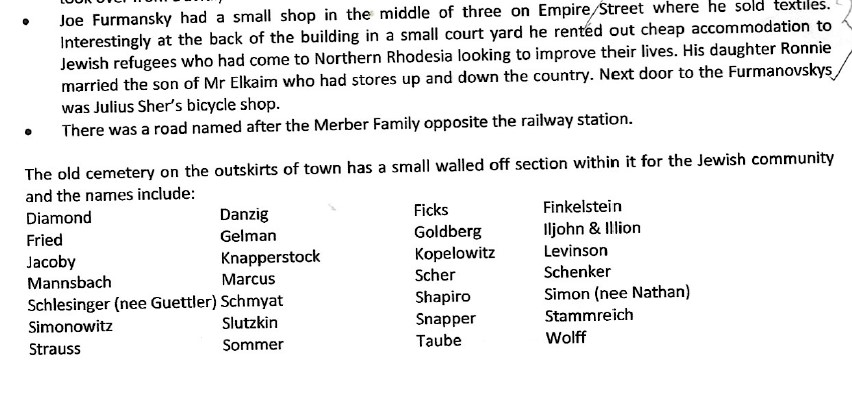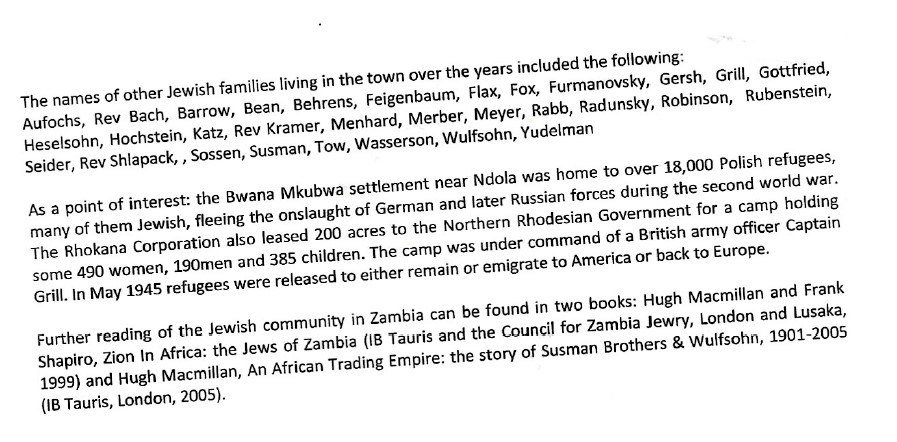Zambian Jewish Community
Page updated 5th June 2024
The Zambian Jewish community reached its peak during the 1960s, a period of significant historical and political changes in the country. At that time, the Jewish population in Zambia numbered around 1,200 individuals. These Jewish settlers played an essential role in various aspects of Zambian life, including trade, commerce, and local politics.
Northern Rhodesia, as it was known before Zambia gained independence, attracted Jewish immigrants seeking economic prosperity. The Susman brothers, who arrived from Lithuania in 1901, exemplified this trend. They established successful ventures in cattle trading, ranching, and copper mining.
However, following Zambia’s independence in 1964, there was a significant exodus of Jews and white individuals from the country. Many Zambian Jews relocated to the United Kingdom, Australia, or Israel. Today, the Jewish community in Zambia is much smaller, with fewer than fifty Jews remaining.
Despite its reduced size, the Zambian Jewish community left a lasting impact on the country’s history and development.
Alternative sources :
(1) Zambian president visits Israel, meets with Herzog – The Jerusalem Post. https://www.jpost.com/israel-news/article-753334.
(2) Zambia to get first rabbi in six decades – JNS.org. https://www.jns.org/zambia-to-get-first-rabbi-in-six-decades/.
(3) History of the Jews in Zambia – Wikipedia. https://en.wikipedia.org/wiki/History_of_the_Jews_in_Zambia.
(4) Zambia to Get First Rabbi in Six Decades – Algemeiner.com. https://www.algemeiner.com/2022/12/28/zambia-to-get-first-rabbi-in-six-decades/.
(5) Community in Zambia – World Jewish Congress. https://www.worldjewishcongress.org/en/about/communities/ZM.
Reviews of the book Zion in Africa and Haven in Africa – providing insight into the history of the Zambian Jewish Community
(this review is credited to Jewish Studies Network)
Hugh Macmillan and Frank Shapiro. Zion in Africa: The Jews of Zambia. In association with the Council for Zambia Jewry. London and New York: I. B. Tauris, 1999. ix + 342 pp. Illustrations, maps, notes, sources, index. $59.00 (cloth), ISBN 1-86064-405-8. Reviewed by Yael Even-Levy, Near Eastern and Judaic Studies, Brandeis University. Published by H-Judaic (November, 1999)
From Yiddish-speaking cattle traders and adventurers in the nineteenth century to intellectuals and professionals in the twentieth, Zion in Africa chronicles the history and culture of the small Jewish community in Zambia and affirms that Zambian Jewry, as an ethnic group, indeed exists. The book is supplemented by maps of Zambia (also known before its independence in 1964 as Northern Rhodesia), with its eight neighboring countries in south central Africa, and central African cattle-trails (c. 1900s-1960). In addition to secondary sources, its eleven-page bibliography provides explanations on the sources, list of interviews, archives, and private collections. Photographs from the early 1900s to 1997 provide visual insights into the appearance of Zambian Jewry, their Synagogue, shops, and the like. The book also includes a list of abbreviations, copious endnotes, and a thirteen-page index. The opening chapter provides a wide definition of the “Jewishness” of the people discussed in this book. Unlike the strict religious definition that values maternal descent, the authors provide an ethnic definition to include anyone of Jewish descent, including those who converted to Christianity, and others who consider themselves Jewish through paternal descent and for other reasons. Jews in Zambia are viewed by Macmillan and Shapiro as “a fairly common social phenomenon: an immigrant ethnic group which, through the force of historical circumstances, rather than heredity [specializes …] in a particular field of economic and commercial activity” (p.1).
For the benefit of future descendants, this book lists almost everyone in Northern Rhodesia/Zambia who falls under this category, including those who have emigrated to, were born or raised in, and those who settled for a while and then left. Macmillan and Shapiro’s fascinating in-depth research deals with Jewish settlers and refugees, both men and women, often with meager financial means, who have emigrated to the welcoming Northern Rhodesia/Zambia and became successful to a certain degree. Regardless of how secular or assimilated many of these immigrants were – be they Yiddish-speakers from eastern Europe, German-speakers from Germany, Ladino-speakers from the former Ottoman Empire, or Anglophones from South Africa, England and Ireland — all had in common their ethnic identity and their social position as a minority group. This resulted in building an infrastructure that included such institutions as Hebrew congregations, synagogues, and even a commitment to the secular national movement, Zionism.
The early grain or cattle-traders, risk-taking entrepreneurs, and farmers endured great difficulties, such as widespread anti-Semitism and local racism among the white population, blackwater fever, and bankruptcy. Despite these hardships, they established trading communities along the railway, in the geographic area known as the Line of Rail, and the copper mines on the Copperbelt, they built rural stores, developed farms and ranches, and they played a significant role in developing towns and in the new Zambian industries such as textiles or the Tranz Zambezi Industries (TZI). Macmillan and Shapiro state that “the status of the Jews as economic or political refugees did give them a greater commitment to the development of national interests, and national capital, than most other settlers” (p.291). What is undeniable is that a strong motivation to succeed, the predominance of close-knit family networks, and, what is most important, a system of direct links with London merchants, personal trust, and the extension of credit system were crucial elements that contributed, for instance, to the eventual success of the Diamond family’s business, or that saved the Susmans from bankruptcy.
Zambian Jewry’s investment in the land may be simply summed up with the words of Helen Mohrer, a German Jewish refugee: “Northern Rhodesia was very good to us, and as Northern Rhodesia grew, so we grew with the country” (p.293). Several chapters are devoted to the history of prominent families in a more explicit fashion. Chapter Two, for example, recounts the history of the Susman family from their humble beginnings as cattle traders to their contributions to the economic development of both Northern and Southern Rhodesia. Both brothers Elie and Harry Susman came from an Orthodox family in the Lithuanian shtetl of Riteve. As pioneer cattletraders, they had overcome the risks posed by the tsetse fly, lions, and crocodiles when crossing the Zambezi river. Chapter Four provides information on Moss Dobkins, a Jewish trader who arrived from England in 1905 and died at the age of ninety in 1984.
The information relies upon Dobkins’ diary and his partial autobiography. It describes his life and that of his family, his joining the Northern Rhodesian Volunteer Force, Mobile Column (known also as the Northern Rhodesia Rifles) in World War I, his relationship with Christian missionaries and Freemasonry, and “how it felt, and what it meant, to be an immigrant Jew in central Africa in the early years of the twentieth century” (p.70). Abe Galaun, discussed in the tenth chapter, is another example of economic success. This chairman of the Lusaka Hebrew Congregation and former member of the Lusaka Chamber of commerce arrived as an immigrant from the shtetl of Vorne in the Russian Empire. Abe Galaun and his siblings came to Africa “because the United States was effectively closed to them by the quota system” (p.182). With their agricultural activities, the Galauns flourished economically in the country, even during the post colonial period of economic decline, as owners of eight farms totaling 25,000 acres of land, and of a vast amount of retail businesses such as butcheries, grocery stores, a hotel, and the first non-segregated movie theater in Lusaka. Their contributions to the economic development of Zambia manifested itself by supplying cattle, developing dairy production, and exporting tobacco, coffee, and horticultural items.
Macmillan and Shapiro give us some information, although not enough, about the Jewish women who emigrated to the area although they admit that women held a central role in the formation of a Jewish community life in the region. Their absence on the frontier in Northern Rhodesia in the early years may help explain the difficulties in observing religious customs. Macmillan and Shapiro tell us that “it was only with the arrival of Jewish women and the formation of families, which went together with the development of modern towns along the Line of Rail, that there was any attempt at organized religious activity” (p.207). Women such as Frieda Glasser, Helenne Illion, Peggy Rabb, or Hessie Lowenthal, just to name a few, were active and independent. The devoutly orthodox Frieda Glasser, for instance, owned the first bakery and dairy in Lusaka. We learn that Peggy Rabb, the federal president of the Women’s International Zionist Organization (WIZO) and national president of the Union of Jewish Women, was also the former president of the Women’s Institutes of the Federation, and former member of the Northern Rodesian Education Advisory Board.
These women were clearly active in Jewish communal organizations and were important in the building of Hebrew congregations, but unfortunately we do not learn about them in this book as much as we do about the men. In addition to the detailed accounts of the early days on the frontier, the strongest part of Zion in Africa is the in-depth examination based on archival documents and immigration files such as the 1930s Colonial Office discussions about Jewish immigration which opposed Jewish settlement in the area. The hardship involved in the settlement and absorption of Holocaust survivors in the region is another interrelated issue addressed in the book. Unlike the earlier settlers who spoke Yiddish, the newcomers spoke German and were assimilated into German culture resulting with a difficult period of adjustment. Zion in Africa includes Jewish involvement in politics and contributions to Zambia’s history, all the while not neglecting to provide the reader with a general history of central and southern Africa and providing details on several riots on the Copperbelt and government mismanagement. Contributions to public life and involvement in local government are manifested in the position Jewish men held in this arena. Among them, just to mention a few, are Hyan Schulman, the first Jewish mayor of Ndola in 1937, Maurice Rabb twice mayor of Livingstone in 1951 and 1956, and Dennis Figov, twice mayor in Luanshya. In the national politics, the civil engineer Simon Zukas was appointed in 1991 deputy Minister to President Chiluba’s Zambian government. This immigrant refugee resigned following political disagreements with the new constitution which “contained clauses debarring immigrants, or their children, from running for the office of President” (p.258). The book at times is too detailed. Nevertheless, its lucid style makes the fifteen chapters a pleasure to read. Although mentioned briefly, more attention perhaps should have been given to the relationship between the Jewish minority and the African majority and other immigrant groups, or to the African shop-assistants’ and customers’ perceptions of the Jewish immigrants. But that may
be a topic for a whole new book. Although Macmillan and Shapiro prove that Jewish immigrants were able to adapt quickly to tropical Africa in the years before and after independence, this volume emphasizes, and almost glorifies, the economic role of Zambian Jewry. Expressing their concern that such a book may be useful to anti-Semitic theorists, Macmillan and Shapiro say the economic roles of Zambian Jewry fits more closely with Braudel’s view of “showing that their relationship to places of economic growth was as much symbiotic as catalytic ” (p.287). To our great benefit, Macmillan and Shapiro succeed in using their subject matter to the fullest and thus fulfil the book’s potential. Zion in Africa is quite enlightening and accomplishes what it sets out to do with great skill and insight and provides a welcome addition to other books dealing with Jewish communities in Africa, such as B.A. Kosmin, Majuta: A History of the Jewish Community of Zimbabwe (Gwelo, 1980); M. Kaplan, Jewish Roots in South African Economy (Cape Town, 1986); G. Saron and L. Hotz (eds.), The Jews in South Africa: A History (Cape Town, 1955); G. Shimoni, G. Jews and Zionism: The South African Experience, 1910-67 (Cape Town, 1980); I. Suttner (ed.), Cutting Through the Mountain: Interviews with South African Jewish Activists (London, 1997); S. Mendelssohn, The Jews of Africa (New York: 1920); and J. Williams, Hebrewism of West Africa: from Nile to Niger with the Jews (New York, 1967). Zion in Africa may be best categorized in the field of social history and the reader should find the biographical details valuable and interesting. By the 1960s most Jews left Northern Rhodesia. Although the Zambian Jewish community of the 1990s is much smaller that it used to be following World War II, it still exists and should be recognized as Zambian Jewry. Zion in Africa makes a substantial contribution to our understanding of a Jewish community in Africa. Specialists in Jewish Studies may welcome this book for the information it presents on this littleknown topic. This volume may be also valuable to readers interested in immigrant communities or to economic development on this continent. Finally, Zion in Africa should find its place in every college and university library. Copyright (c) 1999 by H-Net and JSN, all rights reserved. This work may be copied for non-profit educational use if proper credit is given to the author and H-Judaic. For other permission, please contact the JSN.
[source : The Association of Jewish Refugees http://www.ajr.org.uk/pastjournal33.htm ]
An accusation
Bill Oakfield
Haven of refuge
Between 1939 and 1945 a total of 225,000 German and Austrian Jews perished in the Holocaust, including 90 per cent of the parents of those who came to England under the Kindertransport scheme. We all think that we know why our families died in the Shoah. We thought that all countries had closed their borders to Jewish refugees in 1938/39.
Right? Wrong. There was one country to which no Jew was ever refused a visa – the British protectorate of Northern Rhodesia (later Zambia). But the existence of this haven of refuge was kept a closely guarded secret by the very people who had been charged by the British Colonial Secretary to facilitate mass immigration of Central European Jews to Northern Rhodesia from mid-1938 to the outbreak of the Second World War: the Anglo-Jewish leadership.
The British Colonial Secretary, Malcolm MacDonald, was the instigator of the scheme. The British Government, including the Foreign Secretary, Lord Halifax, was in favour and tried its very best to facilitate its implementation. MacDonald was friendly with the Anglo-Jewish leadership and persuaded Lionel de Rothschild, Lord Bearstead and others to form a Planning Committee. However, this body, for reasons of its own, refused to take the urgent steps necessary to implement the scheme.
In 1989 the Zambian Jewish Community commissioned Frank Shapiro to research and write the history of the Jews of Northern Rhodesia. Among the papers he examined were references to the immigration of European Jews in the 1930s. Shapiro’s historical quest led him to the Public Record Office in London (now the National Archives at Kew) and to hitherto classified government files, sealed for over 50 years.
This mosaic of evidence confirms that a substantial number of Jewish refugees could have been saved and allowed to settle in Northern Rhodesia. Mr Shapiro presented his findings in 2002 in his book Haven in Africa (published by Gefen in Israel and New York), in which he described all the settlement schemes which were examined and rejected.
‘A closely guarded secret’
Experts considered for mass settlement 13 schemes, some of which were eminently suitable, with huge, fertile areas of arable land and plenty of water resources, and almost empty of any population, white or black. The Anglo-Jewish leadership even sent out a Commission to Africa to examine the possibilities. But the Planning Committee procrastinated and did precisely nothing. Only 250 individual Jews managed to reach Northern Rhodesia. Everyone was admitted, some even without a visa, and all the time the availability of visas for Northern Rhodesia was kept a closely guarded secret. Not one letter, not one telegram was sent to German and Austrian Jewish escape committees. If the facts had become known, thousands would have besieged the British embassies for visas to Northern Rhodesia, especially after Kristallnacht, when people were desperate to go anywhere to escape the Nazis.
So why did the Jewish Planning Committee keep the Northern Rhodesian.scheme a secret? Frank Shapiro explains it this way: ‘While they were more than conscious of their obligations to their European coreligionists, they were also determined to protect their own positions in British society. For the Anglo-Jewish leadership during the Nazi crisis the overriding priority was to defend their status as loyal British subjects and, at the same time, retain their stature in the Jewish Community and not feel threatened by any antisemitic claim of dual loyalty.’
I lived in England for 55 years and know from personal experience that this typical Anglo-Jewish leadership view, while prevalent, was also wrong. I always found that British people had a sense of fairness and admired those who were unafraid and stood up for Jewish rights.
The fact remains that the Planning Committee kept the matter a total secret and even managed to convince the British Government to retain the file in secret archives. Even after the war was over, the people concerned did not reveal what they knew.
The question has to be asked: why? Because the Anglo-Jewish leadership was ashamed of its disgraceful conduct and naturally did not want it to become known that they had failed to save the endangered German and Austrian Jews, including my mother and father, who perished at Auschwitz-Birkenau. Theirs was one of the most disgraceful incidents of failure to save fellow Jews, for which they deserve to be condemned.
Now in my 81st year, living with my memories of these terrible days, I will never forget and never forgive.
[The views expressed in this article are not necessarily those of the Association of Jewish Refugees nor of the ZJC website – Ed. ]
[Editor’s Note : In the manuscript entitled “Rhodesian Jewry and its Story” by Eric Rosenthal posted on this website reference is made to the issue raised in this article – click here ]
.
15th May 2016
This kind of article doesn’t appear very often in any press and so thanks to Aviva Ron and Michael Galaun for sharing it with us….SARAF is the association of chiefs in Zambia (all the chiefs belong) and this was published in the Times of Zambia (Ndola) on 12/5/16. If you recall the Zambian Jewish Community donated a large amount of money to the Medical School of Ndola and to the Medical School of Tel Aviv University.
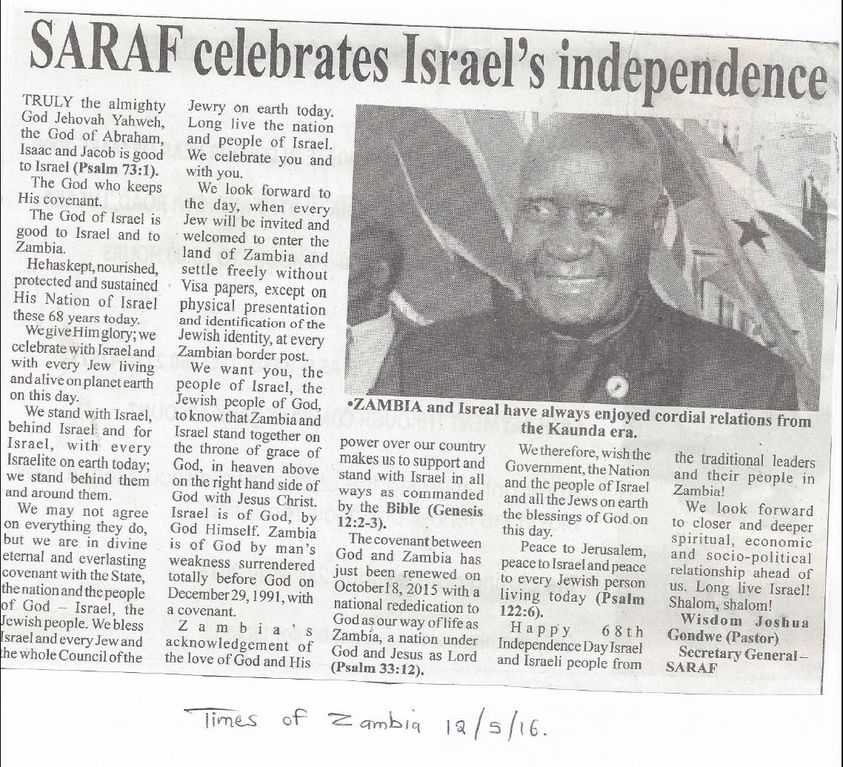
With thanks to Simon Lewis for this cutting on the right from just over 100 years ago in a Livingstone newspaper including a detailed report of a Jewish wedding.
